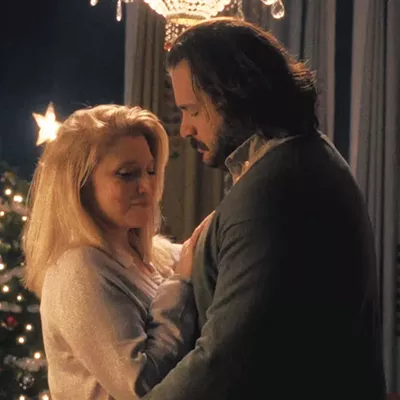Horse racing movies have come and gone in the past. Phar Lap is one of the best, Casey's Shadow is underrated, The Story of Seabiscuit (a 1949 Shirley Temple vehicle) is one of the sappiest. But the genre now gets a full-fledged, good old-fashioned feature film treatment in Gary Ross's excellent adaptation of the terrific Laura Hillenbrand book about the horse that -- legend says -- helped America get through the Depression.
Check back on any news accounts in the mid- to late 1930s; there's no doubt that Seabiscuit, the runty but spunky horse with a crooked leg, was the biggest sports star of his day. People attended his races or listened to them on the radio not just to gamble, but to follow the exploits of the little horse that could, the loser who beat the odds and became a true folk hero.
But the film is about far more than the horse. It's about the three men who hooked up with him -- three men who had been through variations of Seabiscuit's tough early days, when he lost race after race, showed none of the spirit his prize-winning father was known for, and was most likely abused by his owners.
Approximately the first quarter of the film deals with the character development of the trio who will eventually become "Team Seabiscuit." Charles Howard (Jeff Bridges) is a successful businessman who loses his son in a car accident, which eventually causes the disintegration of his marriage. Tom Smith (Chris Cooper) is a loner and drifter, a man who shies away from people, sleeps outdoors, is always looking for work, and has an almost mystical ability to communicate with horses. Red Pollard (Tobey Maguire) has had it rough since his parents abandoned him when he was young, and who has become a scrappy, not very talented jockey and an even worse boxer. All three actors are great in their parts, but only Bridges gets to look like himself. Maguire has been saddled with wavy, bright red hair; Cooper's brown locks have been shortened and whitened.
Ross builds his story slowly -- some will complain that it's done too slowly -- but his method serves to make the exciting events of the rest of the film more easily fall into place. "Exciting" is the key word, since the film, besides being a set of character studies, is focused on how amazing the Sport of Kings really is. Nothing is held back, from the brutal "bug boy" races on the amateur circuit to the dangerous high stakes races at professional tracks. (Much of the film was shot at glorious Santa Anita Park in California, where Seabiscuit actually ran). Ross gets his cameras right into the middle of races, right alongside the horses and riders. It's breathtaking stuff.
While certain events are glossed over, minimizing the real-life tragedy of Red Pollard's life, racing purists should enjoy how Ross and his technical advisors have ensured that the races are accurate to the hoofbeat. Jockeys hired to play the parts wore small earpieces and were instructed as to where their horses should be in each filmed race while they were riding. The final synchronized results hold up against actual footage of Seabiscuit's races. For the record, horse races don't get much more exciting than the match race -- a one-on-one competition -- between California's Seabiscuit and New York's War Admiral, in a classic East-West confrontation.
As he did in his first film, Pleasantville, which also starred Maguire, Ross continues to play around with mixing black & amp; white and color, here inserting newsreels, newspapers, and archival footage. He also gives the film a real sense of time and place by adding narration by author-historian David McCullough, whose voice appears sporadically with tidbits of what was going on in America and the effect of Seabiscuit on his fans. Ross also wisely uses another Pleasantville alum, William H. Macy, as fast-talking radio announcer "Tick-Tock" McGlaughlin, for wonderful comic effect.
Critics were generally pleased with Pleasantville, even though ticket buyers weren't all that interested. Perhaps Ross was relying too much on mood over story in that one. Here he concentrates on storytelling, and does so in remarkably economic manner. He covers a lot of ground in very few words, in incidents such as the death of Charles Howard's son, the brief courtship and marriage of Howard and his second wife, Marcela (Elizabeth Banks), and the revelatory and funny moment when Tom Smith perceives that Seabiscuit and Red Pollard are made for each other.
Hardcore fans of Laura Hillenbrand's book may be slightly disappointed that major events have been left out of the film. But the spirit, intensity, and slight sadness of the book is all there, and the 135-minute running time feels just right. If you haven't read the book, see the film first. Later on, you'll enjoy the book even more.
















